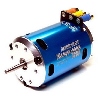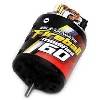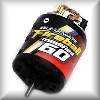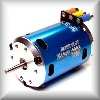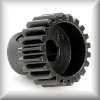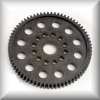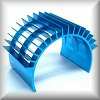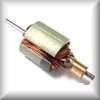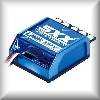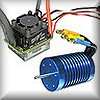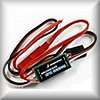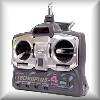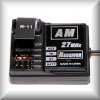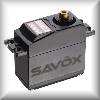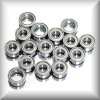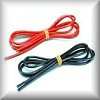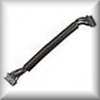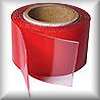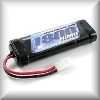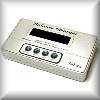Tuning Tips, for Brushed and Brushless Electric Motors
1/ For top level Brushed Motor racing, strip, clean, skim and fit new brushes to your motor every 5 or 6 runs. And don't forget to oil the bearings with light sewing machine oil or ZX1. For Brushless Motors, Clean and re-oil the bearings every 2 or 3 meetings (Check out our "get the best from your bearings" section).
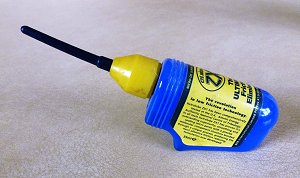 2/ Never over gear your motor. On Brushed Motors, check the brushes after each run and if the ends of the brushes are blue (this means the lubrication in the brushes has been burnt away and is causing increased friction and wear on the comm.) change them straight away and either lower your gearing or fit a weaker spring. If you don't have weaker springs you can try bending a pair of stiff springs with a pair of snipe nose pliers.
2/ Never over gear your motor. On Brushed Motors, check the brushes after each run and if the ends of the brushes are blue (this means the lubrication in the brushes has been burnt away and is causing increased friction and wear on the comm.) change them straight away and either lower your gearing or fit a weaker spring. If you don't have weaker springs you can try bending a pair of stiff springs with a pair of snipe nose pliers.
3/ A cool motor is an efficient motor. And that goes for Brushless as well as Brushed Motors.
Have you ever noticed that as the race nears the last minute or so your car seems to lose its punch out of the corners. Well some of this may be due to your batteries dumping (batteries lose their efficiency as they get hotter - ever heard of temperature resistance? You have now.) but your motor also loses power due to heat, as the magnets become less efficient.
My best tip, regarded by some as controversial, is to get yourself a can of liquid nitrogen spray (The kind of thing doctors use to freeze off warts) and lightly spray the motor innards through the end-bell just before a race. If overheating is a problem, you could also spray the motor heat-sinks, but remember, overuse of liquid nitrogen can be dangerous and can cause damage, so please be careful.
4/ On Brushed Motors, to increase power, reduce friction, arcing and therefore heating the motor to some degree, try a drop of ZX1 on the face of each brush before a run. The effect only lasts maybe 3 or 4 laps but it may be enough to get your nose infront.
5/ During a re-build of your Brushless Motor, when you come to replace the Rotor, place a rolled up piece of paper into the Can to protect against damage, then carefully pull the paper out before replacing the endbell.
What you Need to Know about Electric Motors for RC Models
Winds and Turns
Q/ What does 15x2 or 17x3 mean?
A/ The first number relates to the number of times the wires are wound round each of the 3 armature segments, the second number relates to the number of wires side by side. So a 15x2 would have 2 wires laid side by side and wrapped around each segment 15 times.
Q/ What is the difference in performance between a Low Turn motor (eg 11x1) and a High Turn motor (eg 27x1)?
A/ A Motor with Less Turns like an 11x1 means high current draw from the batteries which corresponds to less runtime, but More Power (Torque or Punch) Best for tracks with lots of corners and short straights where fast acceleration is needed. (use a small pinion)
Motors with More Turns like a 27x1 give you More runtime, but Less Power. So you get a smoother response and are therefore easier to drive. Better for less experienced drivers and Long straight, sweeping corner tracks. (with a large pinion) This is correct for Brushed, Modified and Stock Motors as well as Brushless Motors.
Q/ How do the number of winds effect a motor?
A/ A Motor with More Winds (number of wires eg 13x5) is less demanding on the battery and smoother in acceleration. Best for low grip, slippery tracks.
A Low Wind Motor (eg 11x1) is more punchy and can be difficult to handle. Best on high grip, hot weather Tarmac, or indoor carpet, high acceleration, low speed tracks.
Advance and Retard
Q/ What is Advance and Retard?
A/ On the Endbell of a Modified Motor (where the brushes fit) you will find two screws that hold the Endbell to the Can. If these screws are slackened off slightly the Endbell can then be twisted either Clockwise (Advance) or Anticlockwise (Retard). On Sensorless Brushless Motors this adjustment can generally be made in a similar way (although there are some Brushless Motors that have fixed timing for Spec level racing). Sensored Motors can be adjusted via the ESC.
Q/ What does "Advancing" the Endbell position do?
A/ Advancing the Endbell Reduces runtime, increases Punch (acceleration) and RPM to give a higher top speed.
On the down side, for Brushed Motors, the brushes wear faster and the increased current draw creates more arcing thus increased heat and Commutator (Comm) wear. Brushless Motors can lose some efficiency at the end of a race because of overheating due to increased current draw.
Q/ What does "Retarding" the Endbell position do?
A/ On both Brushed and Brushless Motors, Retarding the Endbell Increases runtime, decreases Punch (acceleration) and RPM to give a lower top speed and for Brushed Motors, brush wear and Commutator (Comm) wear is reduced.
Brushed Motor Basics
Q/ What is the effect of hard and soft Brushes?
A/ Basically, Hard brushes give a lower current draw, so consequently give longer run times and lower torque so less punch (acceleration)
Soft Brushes on the other hand increase current draw thus give higher torque and increased acceleration. Of course the down side of this is that Soft brushes wear much faster and must be changed more often. (I change mine when they get to around 5mm)
Q/ How does changing the brush spring change the motor?
A/ If you fit Stiffer Brush Springs your motor will have More power at low revs and also a lower top speed. I only ever fit stiff springs on bumpy tracks to reduce brush bounce.
Weaker springs reduce power but increase RPM so give less acceleration but a higher top speed. Good for long, sweeping, smooth tracks, where you can carry good speed through the corners.
Brushless Motor Basics
Q/ What does the KV rating mean?
A/ KV stands for Kilovolts and indicates the RPM that Motor can achieve with no load per Volt of input.
If a Motor is rated as 4000 KV and is used with a 7.4 Volt Battery, the RPM achievable by that Motor will be ...
4000 x 7.4 = 29600 RPM.
Q/ What is the difference between a Sensored and a Sensorless Motor?
A/ Sensored Brushless Motors have a cable that can be plugged into the motor itself and its accompanying ESC. This allows the ESC to monitor the performance of the Motor and regulate the Current output to the motor to provide smooth acceleration. Advance and Retard timing is automatically done for you to give torque for exiting corners and increased RPM for long straights.
Sensorless Brushless Motors have to be adjusted for Advance and Retard timing via the Endbell (as described above). These motors are cheaper than the Sensored type and do not provide the same control.
Q/ What is the difference between Inrunner and Outrunner Brushless Motors?
A/ Inrunner Brushless Motors have the electromagnets in the "Can" and the central Shafts (Rotors) are permanent magnets. The Rotor spins inside the "Can". Used mainly in RC Cars and Boats.
Outrunner Brushless Motors have the permanent magnets in the "Can" and the electromagnets in the Rotor. In this type the Rotor spins around a fixed Central Shaft, providing Lower RPM than the Inrunner, but increased Torque. Mostly used for model RC Airplanes and Helicopters.
|




